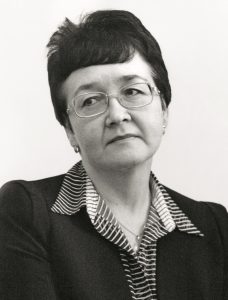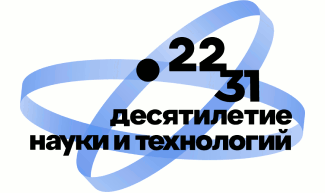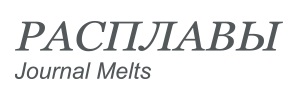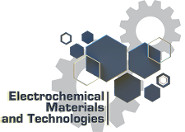 Head of the Laboratory:
Head of the Laboratory:
Liliya Dunyushkina
Tel.: +7(343)362-33-43
e-mail: L_dun@ihte.uran.ru; lidung@list.ru
Web Page
The Key research fields:
Perspective materials for electrochemical devices operating on solid electrolytes and mixed ion-electron conductors have been studied.
-
Developing production methods and studying physical- chemical and electrochemical properties of oxygen, proton, and electron-ion conductors of solid oxide electrochemical devices.
-
Scientific basis for production technologies of thin films for proton conductive electrolytes and research methods of their properties.
-
Kinetics of interaction of oxide materials, prospective for electrochemical applications, with gas phase. Research methods for exchange kinetics and diffusion of light atoms using stable isotopes at the gas phase-oxide boundary for compounds with oxygen, proton or mixed conductivity, and also at the gas phase-electrode-electrolyte triple phase boundary.
-
Theoretical research of solid electrolytes and electron-ion conductors. Developments in the field of microscopic and phenomenological theory of transfer and relaxation processes, thermodynamic properties, defect formation and properties of prospective materials with high ionic conductivity.
-
The Laboratory hosts the Shared Access Centre Composition of Compounds.
Key research methods:
Group of physical – chemical study:
-
Methods applied by the Shared Access Centre “Composition of Compounds”.
-
Method of isotope exchange supplied by gas phase analysis for studying kinetics of interaction between oxygen in gas phase with electrochemical materials.
-
Method of oxygen pressure relaxation for studying chemical exchange and oxygen diffusion, for measuring oxygen nonstoichiometry.
-
Method of hydrogen pressure relaxation for studying hydrogen solubility in proton-conductive oxides.
-
Method of digital processing image REM for electrochemical materials microstructure analysis.
Group of electrochemical materials investigations:
-
Sensitive dilatometric measurements.
-
Conductivity measurements (the impedance method using electrochemical equipment PARSTAT 2273 and Elins, automatized four-point probe techniques, two-probe (oscillographic) technique using rectangular impulse generator) in atmosphere with set values of humidity and partial oxygen pressure.
-
EMF method for measuring ion/proton transference numbers.
-
Thermo-EMF measurements.
-
Solid phase and chemical synthesis of oxide ceramic samples and products with specified properties.
Group of Theoretical investigations:
-
Modern theoretical methods – theory of condensed media, and also computer simulation and modeling (molecular statistics, Monte-Carlo etc).
Key scientific achievements:
Group of physical – chemical study:
-
Techniques required for structural, elemental analysis and microanalysis of substances and materials applied in research practice of IHTE are developed. The basic measurement methods are certified in accordance with GOST P 8.563-96 and registered in the Federal and UB RAS Catalogs.
-
It was proved by isotope exchange method with gas phase analysis that oxygen interface exchange rate increases with rise of acceptor impurity concentration in the Ce1-x GdxO2-x/2-δ, CaZr1-xScxO3-x/2-δ oxides. The effect of two antagonistic factors on oxygen exchange kinetics for the La0.80Sr0.20Ga0.85-xMg0.15CoxO2.825+x/2-δ was identified: decrease of oxygen vacancies concentration and increase of electron defects concentration with rise of electrondonor cobalt admixture concentration.
-
Correlation between defective structure and oxygen mobility in the oxide bulk and at its surface was experimentally demonstrated for the La 1-xSrxCo1-yFeyO3-δ, La 1-x SrxMnO3±δ and LnBaCo2O6-δ (Ln = Pr, Sm, Gd).
-
Role of boundary in the kinetics of gas phase oxygen exchange with compositional materials was detected by analysis of oxygen isotope redistribution at the (1-x)La0.8Sr0.2Mn O3±δ —- xZr0.85Y0.15O1.875 and (1-x) La0.8Sr0.2Fe0.7Ni0.3O3-δ —xCe0.9Gd0.1O1.95–δ composite surface. A model describing dependence of interface exchange rate on composite contents was suggested.
-
Method of oxygen pressure relaxation for studying chemical exchange processes and oxygen diffusion as well as for measuring oxygen nonstoichiometry for mixed-conductive oxide materials was developed.
-
Method of hydrogen pressure relaxation for studying hydrogen solubility in proton-conductive oxides was evaluated.
Group of electrochemical materials:
-
New solid electrolytes based on hafnium oxide with oxygen conductivity were produced. These electrolytes have good conductivity and their chemical stability is higher than that of well-known electrolytes based on zirconium dioxide. New materials can be used in electrochemical devices operating in aggressive and reducing environment.
-
New effective techniques for producing dense solid electrolytes based on CeO2 supplied sintering ceramic with high dense (95-98%) were developed. Proposed technologies are characterized by simplicity, higher efficiency and good reproducibility.
-
Method for producing higher dense ceramics of the BaZr0.9Y0.1O3-α proton-conductive oxides was suggested. The electrical conductivity of such ceramics exceeds the conductivity of samples containing pores by orders of magnitude.
-
For the first time thermodynamic isotope effect in solubility H/D for proton conductive oxides for BaZr0.9Y0.1O3-α using precision dilatometry technique was measured.
-
The study of phase transitions in proton solid electrolytes BaCe1-xNdxO3-δ (x=0, 0.15) was carried out. Some transitions were found for the first time.
-
The phase constituents and electrophysical properties (conductivity, ions and protons transfer numbers) of protonics in the La1-x SrxScO3- α and CaZr1-xScxO3- δ (x= 0.01- 0.20) systems in the wide temperature interval (100-900 ◦C), humidity (pH2O= 0.04-2.65 kPa) and oxygen partial pressure (pO2=2.1∙104-10-15 Pa) were studied.
-
Advanced research of new oxide solid electrolytes with apatite structure was accomplished. The phase constituents and electrophysical properties for wide range of oxide systems based on apatite–like lanthanum silicates and germanates were investigated.
-
New oxide materials based on praseodymium nickelate with high electron conductivity were produced. These materials can be used as cathodes in high temperature electrochemical devices.
Group of Theoretical methods:
-
Thermo-EMF theory for proton conductive oxides was evaluated. The proposed approach described thermo-EMF data and for the first time allowed determining concentration and transfer heat for protons in oxides.
-
Theory of low temperature oxide properties determined by the tunnel centers (OH) was developed. Abnormally large values of isotope effects H/D/T for these properties were predicted.
-
Significant thermodynamic isotope effect H/D/T, its unusual behavior in kinetic isotope effects in proton-conductive oxides was predicted theoretically. The effect was confirmed experimentally.
-
Significant isotope effects H/D in conductivity of “hydrogen-free” current carriers for proton conductive oxides were theoretically predicted. This isotope effect in hole conduction was confirmed experimentally for electrotransport in BaZr0.9Y0.1O3-δ.
-
New method of studying the H/D isotope separation effect in the “nonstoihiometric oxide-gas” system was developed; the theoretical foundations and the first experimental confirmation of the isotope effect H/D for the hydrogen solubility in proton-conductive oxides were suggested.
-
Method of direct statistic-thermodynamic computer simulation and modeling of the nonstoihiometric compositions balance with gas phase for materials with complex electron structure and essentially nonideal ion subsystem was formulated.
-
Theory of defect formation and hydrogen dissolution in acceptor-doped proton conductive oxides based on direct statistic-mechanic description of the oxide-gas balance considering electron-hole and phonon subsystems was proposed. The data on hydrogen solubility and on contribution of different types of carriers to charge transfer for some oxides with fluorite and perovskite structures were explained using this theory.
-
New approach to the issue of phase transition between phases separated by energy barrier (the Kramers problem) using the discrete Wiener-Hopf equation was presented. This served as a foundation for an original process kinetics modeling technique of transfer processes in solid electrolytes which includes impact of medium-thermostat.
Applied research:
-
Software package of SEM image processing for functional electrochemical material microstructure description using the following parameters: porosity, phase fraction (for composite materials), distribution functions of pores sizes, and phase particles, extension of triple phase boundary, surface of grain contacts.
-
Program for calculation the rate of interphase exchange, diffusion coefficient and contribution of three types exchange obtained by isotope exchange method with gas phase analysis. The certificate of authorial registration in RUSPATENT N 20116140003 dated 24.05.2011.
-
Program for calculation of chemical coefficient exchange and diffusion coefficient according to data obtained by electroconductivity relaxation method. The certificate of authorial registration in RUSPATENT N 2011614002 dated 2.05.2011.
-
Software package for the tortuousness factor calculation by the Monte-Carlo method. The certificate of authorial registration in RUSPATENT N 2013660729 dated 18.11.2013.
-
Potentiometric sensors on the base of solid electrolytes for measuring the oxygen partial pressure in gas phase. These sensors are able to determine pO2 in the concentration range from pure oxygen to highly reducing medium containing hydrogen, nitrogen, and aqueous vapor. They are utilized to control vehicle exhaust gases and stationary fuel-firing arrangements in order to decrease noxious emissions and to increase energy efficiency; to control the composition of protected and technological gas medium in electronic industry and processes of thermochemical material treatment, in burning furnaces of ceramic industry; to determine oxygen in molten metals.
-
Electrochemical oxygen pumps which allows to produce extremely pure oxygen and to maintain controlled atmosphere to pO2=10 – 20 atm. They are used in medicine, in research organizations for performing experiments in controlled medium.




